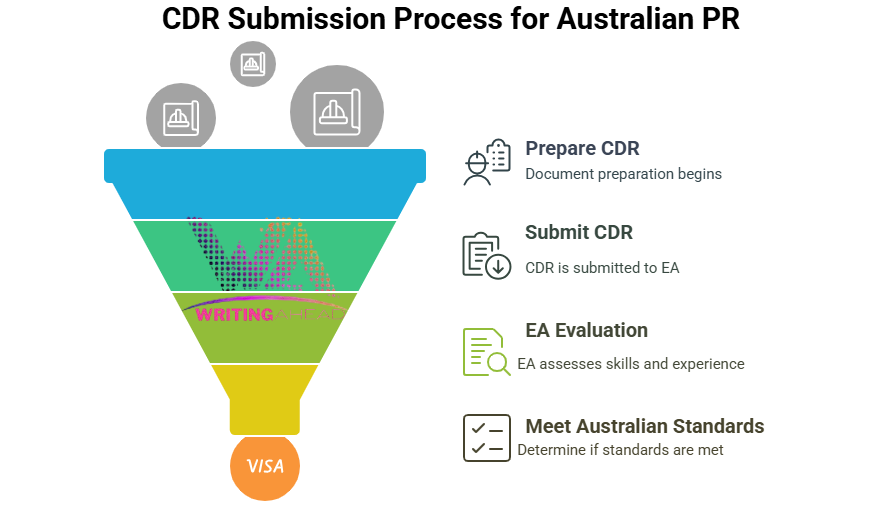For engineers aiming to migrate to Australia, obtaining a Competency Demonstration Report (CDR) approved by Engineers Australia is one of the most essential steps. The CDR is a key part of the Migration Skills Assessment process and is used to assess whether your qualifications and work experience meet the Australian engineering standards.
In this comprehensive CDR Engineers Australia Success Guide for 2025, we will walk you through the process of creating a successful CDR that maximizes your chances of approval. Whether you’re an aspiring migrant engineer or looking to enhance your CDR submission, this guide will offer the essential tips, strategies, and insights for a successful CDR application in 2025.
What is the Competency Demonstration Report?
The Competency Demonstration Report is a detailed document that engineers must submit to Engineers Australia to demonstrate that they meet the required standards for engineering practice in Australia. It is required for individuals who do not have Australian-accredited qualifications but wish to be recognized as engineers in Australia.
The CDR must be structured and formatted in accordance with Engineers Australia’s Migration Skills Assessment criteria. It is a way to evaluate if your skills, qualifications, and experience are equivalent to those of Australian-trained engineers.
The main components of a CDR include:
-
Curriculum Vitae (CV)
-
Career Episodes
-
Summary Statement
-
Continuing Professional Development (CPD)
Why is the Competency Demonstration Report Important?
The CDR is crucial because it is the main document used by Engineers Australia to assess whether you are eligible to migrate to Australia as an engineer. Your CDR submission will be evaluated based on your qualifications, work experience, and engineering competencies. A well-prepared and structured CDR is essential for ensuring you pass this assessment and increase your chances of securing a visa for migration.
Key Components of a CDR
Let’s break down the major components of a CDR to understand how each section contributes to a successful submission.
1. Curriculum Vitae (CV)
Your CV should present a detailed overview of your academic qualifications, professional experience, technical skills, and any certifications you’ve earned. It’s essential that your CV clearly highlights your engineering expertise and aligns with the competencies required by Engineers Australia.
Tips for a Strong CV:
-
Include your educational background, listing degrees, certifications, and relevant training.
-
Detail your work experience with a focus on engineering roles and responsibilities.
-
Highlight any technical skills or certifications that align with Australian engineering standards.
-
Be concise: Ensure your CV is clear and easy to read, avoiding unnecessary details.
2. Career Episodes
The Career Episodes are the heart of your CDR. These are detailed accounts of specific projects or tasks you’ve worked on during your engineering career that showcase your competencies. Each career episode should be aligned with the core competencies set by Engineers Australia.
Each career episode should demonstrate:
-
Your role and responsibilities in the project.
-
The engineering problem or task that you were involved with.
-
The engineering solutions or methods you used to solve the problem.
-
How you contributed to the success of the project.
-
The outcomes of your work and the impact on the project or company.
Tips for Writing Career Episodes:
-
Be specific and detailed: Your career episodes should be focused on your personal contributions to the project, rather than just describing the project as a whole.
-
Focus on competencies: Each career episode should align with Engineers Australia’s Competency Standards. Ensure that your examples demonstrate your skills in design, problem-solving, project management, leadership, and more.
-
Use clear and technical language: Make sure the language you use is technically correct and demonstrates your engineering knowledge.
3. Summary Statement
The Summary Statement is a critical part of your CDR, as it directly links your career episodes to the competency elements set by Engineers Australia. In this section, you must provide a concise, clear explanation of how each career episode aligns with Engineers Australia’s competency criteria.
Tips for Writing the Summary Statement:
-
Use bullet points to match the competencies with your career episodes.
-
Be concise but thorough: You need to demonstrate that your career episodes directly address the required competencies.
-
Keep it simple: While technical language is important in your career episodes, in the summary statement, make sure to clearly show how each experience matches Engineers Australia’s requirements.
4. Continuing Professional Development (CPD)
Engineers Australia requires that you demonstrate a commitment to Continuous Professional Development (CPD). This shows that you are actively engaged in learning and staying updated with the latest developments in your engineering field.
What to Include in CPD:
-
Workshops, seminars, or courses you have attended.
-
Certifications or further qualifications obtained.
-
Professional training related to your field of engineering.
-
Self-directed learning such as reading industry journals, research papers, or online courses.
Tips for CPD:
-
Keep a detailed log of all CPD activities throughout your career.
-
Ensure that your CPD activities are relevant to your field of engineering and show how they contribute to your professional development.
Tips for Writing a Successful CDR in 2025
Creating a successful CDR in 2025 requires meticulous planning, organization, and attention to detail. Here are some crucial tips to ensure your submission stands out and increases your chances of success:
1. Understand Engineers Australia’s Competency Standards
Before you begin writing your CDR, take time to understand Engineers Australia’s Competency Standards. These standards outline the knowledge, skills, and attributes engineers must demonstrate to be recognized as qualified professionals. Aligning your career episodes with these competencies will ensure your submission meets the necessary criteria.
2. Be Honest and Transparent
Make sure that all the information provided in your CDR is accurate and verifiable. Engineers Australia checks for plagiarism and can reject applications that contain dishonest or copied content. Be honest about your roles, responsibilities, and contributions to each project.
3. Focus on Your Contribution
The Career Episodes should focus on your contributions to the projects, not just the outcomes. Ensure that you highlight how you used your engineering knowledge and skills to solve problems and contribute to the success of the project.
4. Avoid Generic Statements
Avoid vague or generic statements such as “I contributed to the project.” Instead, provide specific examples of the work you did, the challenges you faced, and the solutions you implemented.
5. Provide Clear and Concise Examples
The key to a successful CDR is providing clear, concise, and detailed examples that demonstrate your engineering competencies. Each example should reflect how you applied engineering principles to solve a real-world problem.
6. Format and Structure Matter
Ensure that your CDR is well-organized, easy to read, and follows the required format provided by Engineers Australia. Use headings, subheadings, bullet points, and clear paragraphs to organize your content. A well-structured CDR is easier for assessors to read and understand.
7. Seek Professional Assistance if Needed
If you’re unsure about your ability to create a strong CDR, consider seeking professional assistance. Many consultants specialize in helping engineers prepare their CDRs to meet Engineers Australia’s standards. Professional services can guide you through the writing process, ensuring that your submission is well-crafted and error-free.
Common CDR Report Writing Mistakes to Avoid
To ensure your CDR is successful, avoid these common mistakes:
-
Inadequate career episodes: Failing to provide specific examples or clearly showing how they meet the competencies.
-
Overloading with unnecessary information: Keep your CDR concise and focused on what is relevant.
-
Plagiarism or copying from other sources: This can lead to immediate rejection of your application.
-
Lack of alignment with competency standards: Make sure your career episodes directly reflect the competencies expected by Engineers Australia.
Conclusion
Writing a successful CDR for Engineers Australia in 2025 is a crucial step toward migrating to Australia and becoming a recognized engineering professional. By carefully preparing your career episodes, aligning them with Engineers Australia’s competencies, and ensuring clarity, structure, and accuracy, you can increase your chances of fast approval.
Whether you’re an experienced engineer or just beginning the CDR writing process, following these tips will help you craft a strong application. For further support, consider seeking professional assistance to ensure that your CDR meets all the requirements and stands out to Engineers Australia.
Good luck on your journey toward becoming a certified engineer in Australia!




